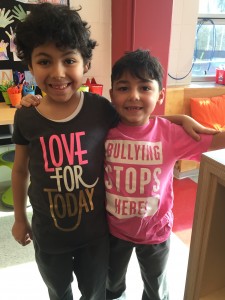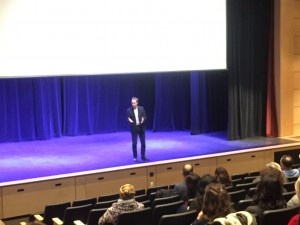 It was Pink Shirt Day on Wednesday all across Canada. It’s an initiative that was started some years ago by two courageous boys in a high school in Nova Scotia. They openly and actively defended a new student, a younger boy in grade 9, who was taking heat from some students for wearing pink. In an act of solidarity and support, the two senior boys got their hands on dozens of pink t-shirts and issued them to boys as they entered the school one morning.
It was Pink Shirt Day on Wednesday all across Canada. It’s an initiative that was started some years ago by two courageous boys in a high school in Nova Scotia. They openly and actively defended a new student, a younger boy in grade 9, who was taking heat from some students for wearing pink. In an act of solidarity and support, the two senior boys got their hands on dozens of pink t-shirts and issued them to boys as they entered the school one morning.
From those roots, Pink Shirt Day developed into a national awareness campaign against bullying. In addition to wearing pink, participants are asked to practice acts of kindness and do whatever they can to minimize physical, emotional and online bullying in their communities.
Pink Shirt Day is a call to action to students to build awareness and defend weaker kids whenever and wherever they can.
This campaign reminds me of some striking experiences I had a few years ago while visiting public high schools in Bogota, Colombia. We currently have a couple of Round Square exchange students at LCC from Bogota (Andrea and Juan). Given that Pink Shirt Day is essentially about creating a safe and peaceful learning environment, I’m sure they’re very proud that the most recent winner of the Nobel Peace Prize is their president, Señor Juan Manuel Santos.
From the early 1960s to 2013, known to all Colombians as La Violencia, civil war dominated Colombian life. Last fall, after four years of negotiations with a revolutionary guerrilla group called FARC and other smaller groups, President Santos managed to finalize a peace treaty with the FARC, which had waged a decades-long civil war against the government.
According to a study by Colombia’s National Centre for Historical Memory, 220,000 people died in the conflict between 1958 and 2013, most of them civilians. Also, more than five million civilians were forced from their homes between 1985 and 2012, generating the world’s second largest population of internally displaced persons.
During my visit to Colombia, I had the privilege of seeing and experiencing the country with about two dozen school principals from all around the world. Our focus was on how to build peaceful communities in our schools. After years of civil war, educators in Colombia had much to teach us. We visited 15 schools in several different communities. Two of the visits were particularly memorable:
The first was with student leaders in a large high school who had decided to call themselves “Agents of Peace.” Each young leader wore an armband or a vest identifying him or her as a “Peacemaker.” Believing that there had been too much violence around them for too long, and that adults hadn’t really been able to model peaceful resolution, the students focused on ways to implement peaceful conflict resolution as the top priority in their school. These students were impressive and engaging. They were proud, clear about their priorities, and intentional about establishing peace as a norm in their school and beyond.
The second special visit was a performance at a Colombian arts school with a wonderful private dance troupe. Each of the dancers originally came from the poorest communities or barrios in Bogota. The older dancers (in their 20s and 30s) had been doing this for years and developed into an internationally recognized dance troupe. That day, they modeled how they actively paid it forward with younger students. They showed how they taught young kids from the poorest communities of Bogota how to dance. As the founder and director of the troupe told us, the young students had seen and experienced too much violence and suffered daily from the poverty in their lives. Learning to dance gave them skills, confidence, and a sense of peace and calm – something that was relatively absent in their lives of struggle.
These experiences were important reminders that acts of kindness and agents of peace come in different forms and exist in many different cultures.
I think we all have a responsibility to contribute to sowing seeds of kindness, empathy and care in our communities, wherever we are. Today I think this is particularly important. We don’t have to agree with one another all the time, but we do need to be respectful and accepting of difference at all times. These norms, these foundational values, matter a great deal.
I was proud to wear pink on Wednesday, and hope we will all stand up for the weak or the victims of bullying and harassment, whenever we are aware of it.
My thanks to those students in Nova Scotia and Colombia for reminding us all that we each have an important duty of care in our community. I hope that you regularly practice kindness and acceptance every day. Remember, peace, acceptance and trust form the bedrock of healthy communities everywhere. – Chris Shannon, Headmaster

 Most of us are familiar with the saying “green with envy.” It originated in the works of William Shakespeare who repeatedly warned his readers/audience about the negative impact of “green-eyed jealousy” that exists in all people. More than 500 years later, how is it rearing its head amongst today’s youth?
Most of us are familiar with the saying “green with envy.” It originated in the works of William Shakespeare who repeatedly warned his readers/audience about the negative impact of “green-eyed jealousy” that exists in all people. More than 500 years later, how is it rearing its head amongst today’s youth? Clinical psychologist, Dr. Alex Russell visited LCC a few weeks ago and offered many important messages. He works with struggling adolescents and is the author of the book Drop the Worry Ball: Parenting in the Age of Entitlement. Let’s consider some of the key takeaways from his presentation.
Clinical psychologist, Dr. Alex Russell visited LCC a few weeks ago and offered many important messages. He works with struggling adolescents and is the author of the book Drop the Worry Ball: Parenting in the Age of Entitlement. Let’s consider some of the key takeaways from his presentation. What do our students have in common with former NBA basketball star Wilt Chamberlain and Habs’ goaltending great Jacques Plante? They have all been held back by social conformity, more commonly known as peer pressure. This is not about teen anxiety and the pressures of fitting in with the latest trends. It is about something bigger.
What do our students have in common with former NBA basketball star Wilt Chamberlain and Habs’ goaltending great Jacques Plante? They have all been held back by social conformity, more commonly known as peer pressure. This is not about teen anxiety and the pressures of fitting in with the latest trends. It is about something bigger.